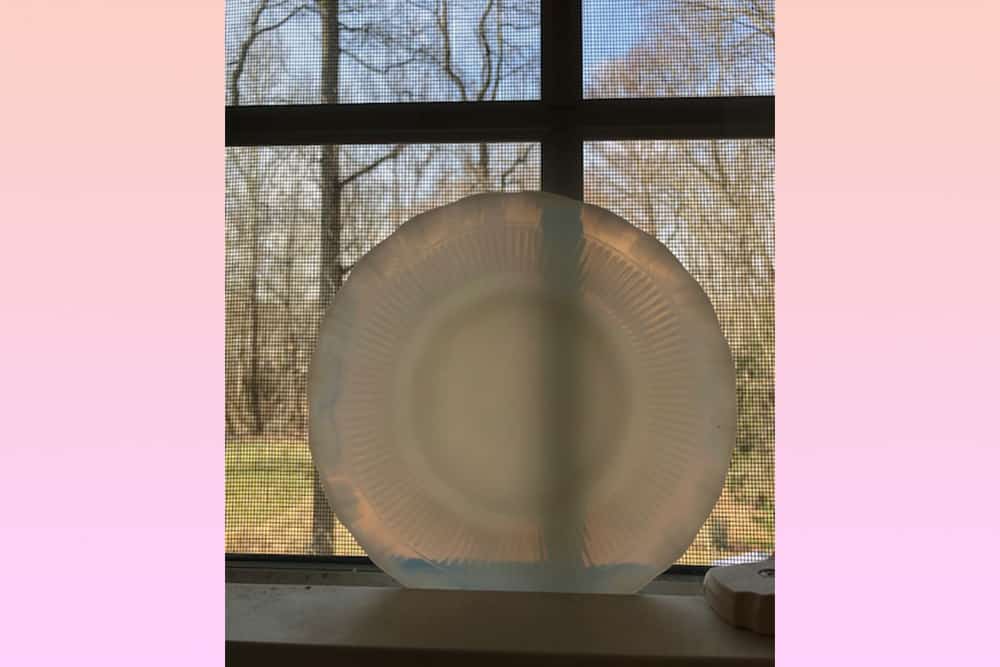
[Image above] An example of the MacBeth–Evans Oxford pattern glassware in the author’s collection, showing the translucent effect. Photo by Becky Stewart, Feb. 24, 2024.
By Becky Stewart
Pittsburgh may be known today as the Steel City, but throughout the 1800s and early 1900s, it was more appropriately known for glass. Today we open a window on this hidden history and the city’s role in the production of Depression glass.
Glassmaking in the US: from colonial times to the Depression
Glassmaking was the first industry established by English settlers in what would become the United States, when a glass furnace was built in Jamestown, Va., in 1608. The economics and the weather were not good in this area, though, and it soon went out of business. Thus, until the early 1700s, any windows or glass bottles in the colonies had to be imported from England.
The first successful glass industry in the colonies was founded by Caspar Wistar in Alloway Township, N.J., in 1739. Southern New Jersey remains a strong center of glassmaking and artistry today, although it was soon supplanted commercially by glass production in Pittsburgh, Penn.
The glass industry put down roots in Pittsburgh in 1797, near the spot seen in the accompanying photograph. The rivers, abundance of high-silica sand for raw material, and ready access to coal for fuel made the tri-state area of western Pennsylvania, eastern Ohio, and the West Virginia panhandle responsible for 80% of the glass made in the United States by 1920. The glass was transported throughout the United States by river and rail, much of it through Pittsburgh.

Depression glass fills a need in US homes
The Great Depression in the United States (1929–1939) decimated demand for the fine crystal that Ohio Valley glassmakers had been producing. To keep their workforces employed, manufacturers pivoted to producing dining sets that could be pressed in large quantities with machines, up to more than a thousand pieces a day. These clear or colored translucent glassware pieces were often given away as promotions to keep consumers in stores.
My fascination with what is today known as Depression glass began in 1990, when I purchased four place settings of the MacBeth–Evans Glass Company’s Oxford pattern glass at an antique store. I didn’t know what it was when I bought it, I just knew I liked the translucent effect. Over the years, however, I accumulated additional pieces of the Oxford pattern tableware and learned more about the history of this company, which was one of many that produced popular glassware patterns during the Depression.
The MacBeth–Evans Glass Company was established in Pittsburgh by a merger between glass companies owned by Thomas Evans and George A. MacBeth in 1899. Its largest glassworks were in Charleroi, Pennsylvania, on the Monongahela River.
In its early years, the company produced chimneys for gas lamps and reflectors for military searchlights. But when porcelain plates became the top choice for fine tableware in the late 19th and early 20th centuries, the company adapted their Monax glass, previously used for light fixtures, to dinnerware. Its translucence gives Monax glass the delicate appearance of porcelain with much greater strength. Although it is often confused with milk glass, milk glass is not translucent.
Complete dinnerware lines were added to the MacBeth–Evans Glass Company’s offerings in 1930, in response to the Depression and to keep up with competition. The early production years saw the Oxford pattern made using the white translucent Monax. But after the company was bought by Corning Glass Works in 1936, the Oxford pattern was produced in a variety of colors until the 1950s.
After the change in ownership, the glass factory in Charleroi continued to produce tableware and ovenware, including the Corelle and Pyrex lines. The Charleroi factory was sold to World Kitchen in 1998. It continues to produce CorningWare ovenware and Corelle tableware today.
In the 1950s, porcelain regained its prominence as the choice for fine tableware, and Depression glass fell out of production. Collectors can still find many examples at antique stores, auctions, or online (some of my collection was found on eBay). The National Depression Glass Association has a variety of resources for novice collectors.
Further reading
Collected sales catalogs of glassware, Corning Museum of Glass.
Cooper, M., “The colorful history of Depression glass and its continued popularity,” MyModernMet.com, 8 July 2020.
Meechoowas et al., “The comparison of different sand sources for glass industrial production,” MaterialsToday: Proceedings 2021, 47(12): 3445–3448.
Rossi, J.A., A brief history of glass making and its impact on southern New Jersey. Precision Electronic Glass Inc., Vineland, N.J., 1998.
Tumblers and glassware, Corning Glass Works, MacBeth–Evans Division.
What is industrial sand?, Wisconsin Industrial Sand Association.
